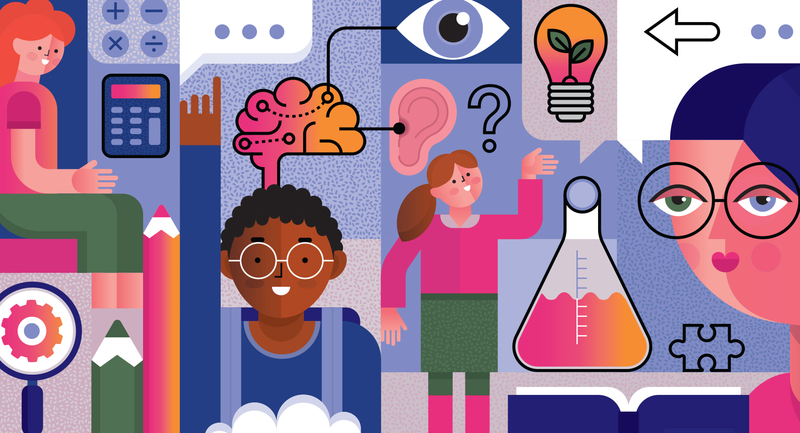If schools are supposed to provide for positive learning experiences and curriculum mastery, why are millions of dollars in support funds withheld until students demonstrate failure? If categorical funds are designed to provide for equitable treatment of student differences, why are the resulting services often compartmentalized and fragmented, leading to inequitable solutions? These are two of the questions that led us to restructure categorical programs in the Edmonds School District in Lynnwood, Washington.
Our goal was an integrated special, compensatory, and basic education service delivery model that would provide effective instruction for all students. The district's only preconceived outcome was that all students would learn at a high level of mastery.
We empowered the schools to group and serve students according to their instructional needs, not their labels and funding sources. Consequently, out of 31 schools, there are 31 different program models—although there are similarities among schools.
Building Consensus for Change
To establish consensus, most schools used some form of leadership team, depending upon their respective decision-making processes. The basic premise was to create a vision: an outgrowth of the staff's examination of what they believe about the role and purpose of school, what they want students to learn and achieve, what they know about how and why students learn, and, finally, what they will do to ensure that all students learn.
Since consensus work requires great time and staff energy, schools were encouraged to take a full year to plan before making any changes. Schools then had a standard by which to measure current practices. The district provided a facilitator and funding for the planning year, along with funds to a lesser degree for every year thereafter. All of the schools now receive ongoing funding as part of their regular building budget.
Overcoming Major Obstacles
A major hurdle to improving the achievement of low-performing and handicapped students was the various categorical program regulations. The notion of targeted funds in and of itself is not detrimental, but use of the funds is laden with regulations that curb creative thinking. From the federal to the state level, infrastructures supporting each categorical program have served to isolate and institutionalize these programs.
The Edmonds School District has not received any special waivers for program regulations. To support schools in their creative deployment of categorical resources, the district “blends” federal, state, and local dollars according to each school's needs. Due to federal regulations that require extensive record keeping to track each employee's “time and effort,” managing the “blending” process is highly labor-intensive and is absolutely counter to improving education for students. However, we believe it is necessary to promote school-centered decision making and reform.
One promising outgrowth of the district's involvement with this project has been legislation at the state level that allows us to receive funding for learning disabled students without having to formally label students for special education. The need for this legislation points out a major obstacle in that special education funding is most often determined by how many identified students are enrolled according to a variety of handicapping conditions. With particular respect to mild handicaps such as learning disabled, the label has little or no relationship to what is needed in terms of curriculum and instruction. In that case, the only reason many students are being labeled and tracked in special education is to receive funding.
Celebrating Program Outcomes
In their reform efforts, district schools have focused primarily on structural changes and program enhancement. Because teaching positions are now blended, job titles such as Chapter I teachers or special education resource room teachers no longer exist. Support teachers—called “learning support”—are funded out of several sources. In addition, teachers are using different grouping strategies such as within-grade, cross-grade, multiage, and in-class services. There is no outward district intent to “do away with pull-out.” Our aim is to provide maximum flexibility for schools to experiment with different structures.
Schools have also concentrated on the causes of student failure by attempting to enhance learning opportunities. For example, they are exploring options in cooperative learning, study skills, social skills, learning styles, self-concept, thematic curriculum, guidance support, and peer/teacher tutoring.
Evaluating Our Progress
While the schools are working to develop alternative methods of assessment, the basic measure of achievement has remained standardized achievement tests. Despite its drawbacks, this form of testing has provided a comparative data base for examination. We administer tests annually for all students grades 1–8; state-mandated testing occurs at 4th, 8th, and 10th grades.
Over several years, we have documented the progress of targeted students, although the exact variables have been difficult to isolate. For each subject, the district is currently tracking nine different service delivery models (grouping strategies), the amount of instructional time, and the type of service provider (teacher, assistant, and so on). While several factors are emerging as potentially high correlates for student achievement, more years of data gathering are needed. In addition, we need to add new variables to the evaluation, such as types of instructional approaches and curriculum.
The fact that targeted students have made statistically significant gains compared to their nontargeted counterparts has demonstrated the efficacy of integrating students. Nevertheless, we must continue to search for ways to prevent students from experiencing failure in the first place.
What We Are Learning
An important distinction needs to be made between restructuring service delivery and total school improvement. In some schools, teachers have teamed to better serve students. For example, a special education teacher who once taught a self-contained classroom might pair with a basic education teacher to integrate students. While we encourage such experimentation, we also believe that school improvement is a long-term effort that involves the entire staff, structure, curriculum, and instructional methodology. Improvement focuses on the values, beliefs, attitudes, and culture of the school. Schools must spend the necessary time engaged in the hard work of visioning.
Six years of restructuring efforts have reinforced for us the value of school-centered decision making. The quality of group process is the key to successful school reform. The variability in degrees of staff satisfaction across the district is attributed most to the quality of group process at each school.
We've also learned that change cannot be mandated from the central office. The ultimate charge for district-level leaders is to create a learning organization that empowers staff to develop a shared vision for the future of their school—a vision that holds as sacred that every child is capable of learning and that it is our responsibility to create the conditions for that child to be successful.







